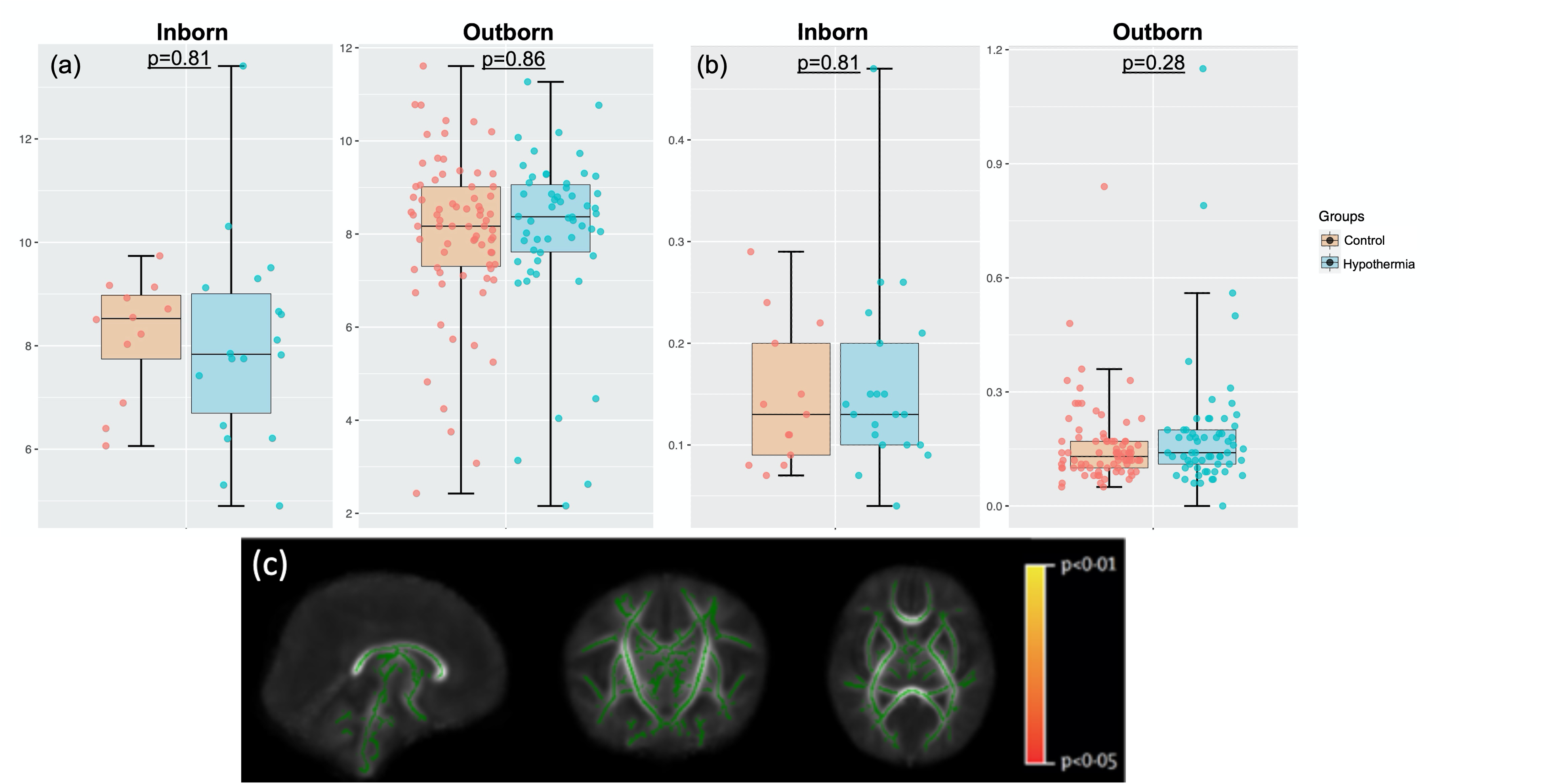Back
Neonatal Neurology: Clinical
Category: Abstract Submission
Neurology 7: Neonatal Neurology Term Imaging
351 - Magnetic resonance assessment of hypothermic neuroprotection amongst babies born inside or outside of a cooling centre: a secondary analysis of the HELIX Trial
Monday, April 25, 2022
3:30 PM – 6:00 PM US MT
Poster Number: 351
Publication Number: 351.443
Publication Number: 351.443
Phoebe Ivain, Imperial College London, London, England, United Kingdom; Paolo Montaldo, Imperial College London, London, England, United Kingdom; Vijay Kumar, Imperial college london, London, England, United Kingdom; Vaisakh Krishnan, Imperial College, London, PALAKKAD, Kerala, India; Stuti Pant, Imperial College London, London, England, United Kingdom; Josephine I. Mendoza, Imperial College London, London, England, United Kingdom; Maria Moreno Morales, Imperial College London, London, England, United Kingdom; Deepika Shukla, Imperial college London, London, England, United Kingdom; Prathik Bandiya, Indira Gandhi Institute of Child health, Bangalore, Karnataka, India; Chinnathambi N. Kamalarathnam, Madras Medical College, Chennai, Chennai 85, Tamil Nadu, India; Mohamed Sajjid, IOG and Govt. Hospital for Women and Children, Chennai, Tamil Nadu, India; Swati A. Manerkar, Lokmanya Tilak Municipal Medical College, Mumbai, Maharashtra, India; Jayashree A. Mondkar, LTM Medical college & GeneralHospital, Mumbai, Maharashtra, India; Ismat Jahan, Bangabandhu Sheikh Mujib Medical University ( BSMMU), Dhaka, Dhaka, Bangladesh; Sadeka C. Moni, Bangabandhu Sheikh Mujib Medical Univetsity, Dhaka, Dhaka, Bangladesh; Mohammod Shahidullah, Bangabandhu Sheikh Mujib Medical University (BSMMU), Dhaka, Dhaka, Bangladesh; Ranmali Rodrigo, University of Kelaniya, Ragama, Western Province, Sri Lanka; Samanmali Sumanasena, University of Kelaniya, Ragama, Western Province, Sri Lanka; Radhika Sujatha, SAT Hospital, Government Medical College, Thiruvananthapuram, Thiruvananthapuram, Kerala, India; Ronit M. Pressler, Great Ormond Street Hospital, London, England, United Kingdom; Seetha Shankaran, Wayne State University School of Medicine, Austin, TX, United States; Sudhin Thayyil, Imperial College London, London, England, United Kingdom

Phoebe Ivain, MSc
Research Assistant
Imperial College London
London, England, United Kingdom
Presenting Author(s)
Background: Suboptimal neonatal care and poor transport facilities may negate the effects of therapeutic hypothermia (TH) in babies with hypoxic ischemic encephalopathy (HIE) born outside cooling centres in low and middle-income countries (LMIC).
Objective: To assess the efficacy of TH within inborn and outborn infants with HIE in LMIC using quantitative MR biomarkers.
Design/Methods: Of the 408 infants with moderate or severe HIE recruited to the HELIX trial from South Asian tertiary neonatal care units, 123 were inborn and 285 were outborn (Thayyil et al., Lancet Global Health 2021). 3 Tesla magnetic resonance (MR) imaging and spectroscopy using harmonized sequences was performed in all infants at 2 weeks of age and neurodevelopmental outcomes (Bayley III) examined between 18 to 22 months. MR data masked to allocation were centrally analyzed using LC Model and FSL, following exclusion of poor-quality data using predefined criteria to avoid selection bias. MR images were scored using a previously validated system. Linear regression was used to examine the association between biomarkers and treatment group both unadjusted and adjusted for age at MR, gestational age, time at start of cooling, and severity of encephalopathy.
Results: Of the 408 recruited infants, 114 died and 8 left against medical advice before MR scan, and the caregivers of 2 denied consent. Of the remaining 284 infants, 267 (94%) had MR data – 80 inborn (37TH;43 control) and 187 outborn (85TH;102 control) infants. Baseline clinical characteristics of TH and control group in both inborn and outborn infants were not different, although several short-term adverse outcomes were higher in the hypothermia group (Table 1). Hypothermia was not associated with reduction in brain injury scores both in outborn and inborn infants (p >0.05) (Table 2). Amongst inborn infants, mean thalamic N-acetylaspartate [NAA] was 8.04 (SD 1.98) in TH and 8.19 (SD 1.16) in control infants (p=0.81), and mean lactate/NAA was 0.16 (SD 0.09) in TH and 0.15 (SD0.07) in control infants (p=0.81). Amongst outborn infants, mean thalamic [NAA] was 8.07 (SD 1.82) in TH and 8.02 (SD 1.68) in control infants (p=0.86) and mean lactate/NAA was 0.19 (SD 0.18) in TH and 0.16 (SD0.11) in control infants (p=0.28). There was also no difference in mean fractional anisotropy between treatment groups for either inborn or outborn infants on tract based spatial statistics (Fig1). Conclusion(s): Therapeutic hypothermia does not reduce brain injury after HIE in LMIC, both in babies born in or outside a tertiary cooling centre.
Figure 1. MR spectroscopy and diffusion tensor imaging. (a) Thalamic N-acetylaspartate concentrations from inborn and outborn infants who were in control (red) or hypothermia (blue) groups, (b) Lactate/NAA peak area ratios from inborn and outborn infants who were in control (red) or hypothermia (blue) groups, (c) Mean FA tract skeleton with threshold range of 0.15 (lower) and 1.0 (upper) over regions with no statistically significant groupwise differences in FA between control or hypothermia infants in either inborn or outborn groups. Statistically significant (p < 0.05) regions would be coloured in red and yellow.
(a) Thalamic N-acetylaspartate concentrations from inborn and outborn infants who were in control (red) or hypothermia (blue) groups, (b) Lactate/NAA peak area ratios from inborn and outborn infants who were in control (red) or hypothermia (blue) groups, (c) Mean FA tract skeleton with threshold range of 0.15 (lower) and 1.0 (upper) over regions with no statistically significant groupwise differences in FA between control or hypothermia infants in either inborn or outborn groups. Statistically significant (p < 0.05) regions would be coloured in red and yellow.
Table 2..png) Severity of cerebral lesions in hypothermia and control groups amongst inborn and outborn infants with MR.
Severity of cerebral lesions in hypothermia and control groups amongst inborn and outborn infants with MR.
Objective: To assess the efficacy of TH within inborn and outborn infants with HIE in LMIC using quantitative MR biomarkers.
Design/Methods: Of the 408 infants with moderate or severe HIE recruited to the HELIX trial from South Asian tertiary neonatal care units, 123 were inborn and 285 were outborn (Thayyil et al., Lancet Global Health 2021). 3 Tesla magnetic resonance (MR) imaging and spectroscopy using harmonized sequences was performed in all infants at 2 weeks of age and neurodevelopmental outcomes (Bayley III) examined between 18 to 22 months. MR data masked to allocation were centrally analyzed using LC Model and FSL, following exclusion of poor-quality data using predefined criteria to avoid selection bias. MR images were scored using a previously validated system. Linear regression was used to examine the association between biomarkers and treatment group both unadjusted and adjusted for age at MR, gestational age, time at start of cooling, and severity of encephalopathy.
Results: Of the 408 recruited infants, 114 died and 8 left against medical advice before MR scan, and the caregivers of 2 denied consent. Of the remaining 284 infants, 267 (94%) had MR data – 80 inborn (37TH;43 control) and 187 outborn (85TH;102 control) infants. Baseline clinical characteristics of TH and control group in both inborn and outborn infants were not different, although several short-term adverse outcomes were higher in the hypothermia group (Table 1). Hypothermia was not associated with reduction in brain injury scores both in outborn and inborn infants (p >0.05) (Table 2). Amongst inborn infants, mean thalamic N-acetylaspartate [NAA] was 8.04 (SD 1.98) in TH and 8.19 (SD 1.16) in control infants (p=0.81), and mean lactate/NAA was 0.16 (SD 0.09) in TH and 0.15 (SD0.07) in control infants (p=0.81). Amongst outborn infants, mean thalamic [NAA] was 8.07 (SD 1.82) in TH and 8.02 (SD 1.68) in control infants (p=0.86) and mean lactate/NAA was 0.19 (SD 0.18) in TH and 0.16 (SD0.11) in control infants (p=0.28). There was also no difference in mean fractional anisotropy between treatment groups for either inborn or outborn infants on tract based spatial statistics (Fig1). Conclusion(s): Therapeutic hypothermia does not reduce brain injury after HIE in LMIC, both in babies born in or outside a tertiary cooling centre.
Figure 1. MR spectroscopy and diffusion tensor imaging.
 (a) Thalamic N-acetylaspartate concentrations from inborn and outborn infants who were in control (red) or hypothermia (blue) groups, (b) Lactate/NAA peak area ratios from inborn and outborn infants who were in control (red) or hypothermia (blue) groups, (c) Mean FA tract skeleton with threshold range of 0.15 (lower) and 1.0 (upper) over regions with no statistically significant groupwise differences in FA between control or hypothermia infants in either inborn or outborn groups. Statistically significant (p < 0.05) regions would be coloured in red and yellow.
(a) Thalamic N-acetylaspartate concentrations from inborn and outborn infants who were in control (red) or hypothermia (blue) groups, (b) Lactate/NAA peak area ratios from inborn and outborn infants who were in control (red) or hypothermia (blue) groups, (c) Mean FA tract skeleton with threshold range of 0.15 (lower) and 1.0 (upper) over regions with no statistically significant groupwise differences in FA between control or hypothermia infants in either inborn or outborn groups. Statistically significant (p < 0.05) regions would be coloured in red and yellow.Table 2.
.png) Severity of cerebral lesions in hypothermia and control groups amongst inborn and outborn infants with MR.
Severity of cerebral lesions in hypothermia and control groups amongst inborn and outborn infants with MR.